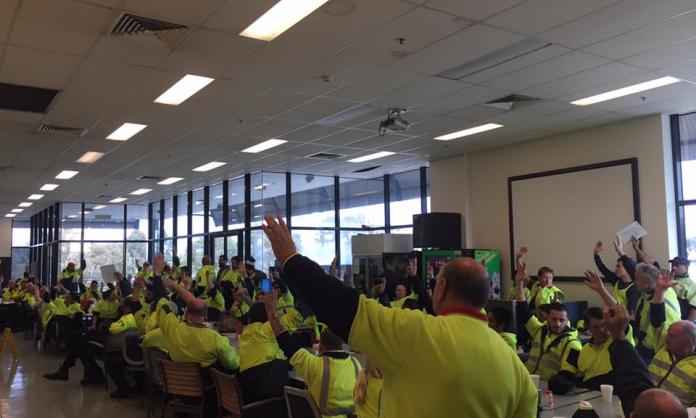While much of Australia’s union movement scratches around for a strategy or is forced into desperate defensive battles to hang on to long established conditions, workers in fresh food and in Victorian distribution centres have achieved some significant advances.
On Wednesday around 1,600 workers, members of the National Union of Workers, voted overwhelmingly to endorse new enterprise agreements at three Woolworths distribution centres in Victoria. The agreements feature pay increases of around 4 percent per year (up to 5.2 percent for some low paid workers), more than double the national average. There are also dramatic increases in redundancy payments (from a previous maximum payout of 40 weeks, to nearly 100 weeks in some cases). This is particularly important for workers at the Hume distribution centre in Broadmeadows, where Woolworths will throw hundreds of workers on the scrap heap in coming years as it shifts to a more automated facility in Dandenong South.
Some long standing local grievances have also been resolved. At the Melbourne Liquor Distribution Centre in Laverton, for instance, workers achieved a ten minute break in a four hour shift. This is an award condition that Woolworths management had previously not given to these workers, many of whom lift heavy boxes of liquor for their entire shift.
It’s a solid industrial result, and one achieved very much against the trend.
For the wider union movement, the take home lesson should be the method through which these gains were achieved: the marshalling of a formidable battery of industrial power.
Distribution centre workers, simply by virtue of their place in production, have a lot of industrial power. Even a short stoppage can cripple an entire supply chain.
The NUW amplified this power by spending a lot of effort, over several years, lining up the expiry dates of the enterprise agreements covering three Victorian sheds.
Australia’s system of enterprise bargaining, imposed by the Hawke/Keating Labor government in the early 1990s, is designed to allow bosses to divide and rule. A major corporation like Woolworths can employ workers through a variety of shelf companies, each with separate enterprise agreements with expiry dates which are years apart, meaning workers doing the same job for the same company can’t legally bargain together.
It’s really only the militant construction industry unions, especially in Victoria, that have maintained pattern agreements with common expiry dates over much of the industry, allowing coordinated industrial campaigns. By lining up the agreement dates, the NUW took a step in this direction – and reaped significant rewards.
It was also important that each of the three sheds in Victoria had a history of industrial action: workers at the Hume DC have been long term industrial pace setters in the industry, workers in the Barnawartha shed near Wodonga had struck in each of its last two agreements, and workers at MLDC staged a spectacular four day strike to keep out labour hire a couple of years ago. So the possibility of legally protected industrial action at multiple sheds was not just some empty threat.
And of course, building up to the dispute in the pre-Christmas period threatened to blow an almighty hole in Woolworths’ network during the company’s busiest and most profitable season.
While the workers made significant incremental gains, they didn’t win their most ambitious claims. Workers at Hume, for instance, had initially demanded a guaranteed right to redeployment across the Woolworths network when their shed closes in 18 months time. Workers at MLDC, half of whom are casual, had asked for a raft of measures to increase job security. In the absence of serious strikes, no major gains were won in these areas.
None of this, however, takes away from the fundamental point that this outcome demonstrates: building industrial power, the ability to take large scale and effective industrial action, is what won the real and important gains in these agreements, and that this is the only path forward for the whole of our union movement.
It’s a similar message from one of the most challenging sections of Woolworths’ supply chain, the farms, where the NUW has been organising for the past two years. There’s a lot of ground to make up: farms and horticulture workers have been largely neglected by Australia’s union movement for generations.
Along with media exposes and cases in courts and tribunals, the NUW has done something that all too few unions do: set out to systematically organise the unorganised. Face to face, worker to worker organising drives have resulted in a string of agreements at particular companies, and the beginnings of worker organisation on the job that can actually enforce these legal entitlements.
The fact that it’s possible for a union to do this in an area as tough as farm work – with workers on a myriad of different visas, or no visas at all, and employers using a constantly shifting collection of shonky (and totally unregulated) labour hire employers, should serve as an example for the rest of the union movement. With well over 80 percent of employees in this country working non-union, there is plenty of scope for every union to be following this example.
On Wednesday, this organising effort took a significant step forward when Woolworths’ top management signed an agreement with the NUW. The agreement includes commitment to a pre-qualification program for labour hire companies in Woolworths’ supply chain, which will be expected to meet minimum legal norms, as well as education about workplace and union rights, and an effective grievance mechanism for workers.
Achieving any or all of these aims would be a real gain for farm workers, and the battle to achieve this will no doubt provide an additional organising focus in the meantime.
Yes, we all want to #changetherules. Our movement demands relief from the ridiculous, anti-worker laws that put so many obstacles in the way of industrial action. But we’re never going to change anything if we sit around waiting. In an era of clicktivism, twitter storms, branding campaigns and similar non-industrial strategies, these wins show that the way to rebuild our unions, both in unorganised sectors and in areas of traditional strength, is by using the most traditional means imaginable: systematic organising and building real industrial power.











